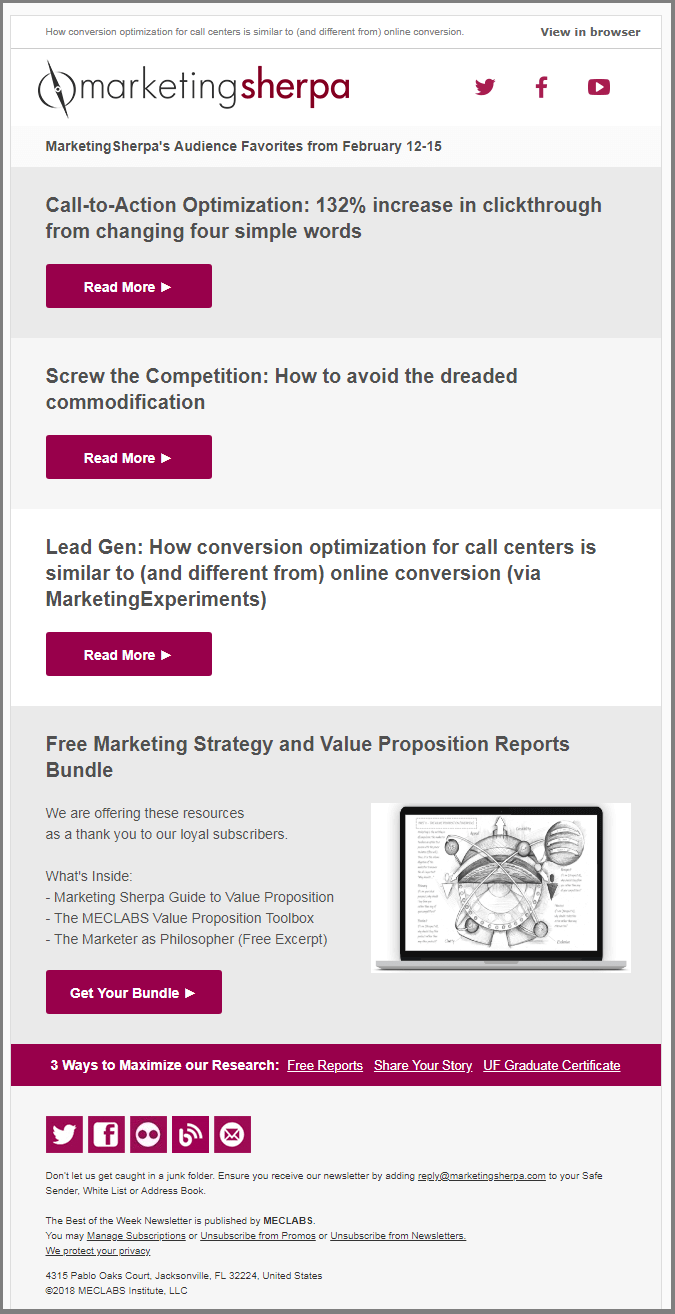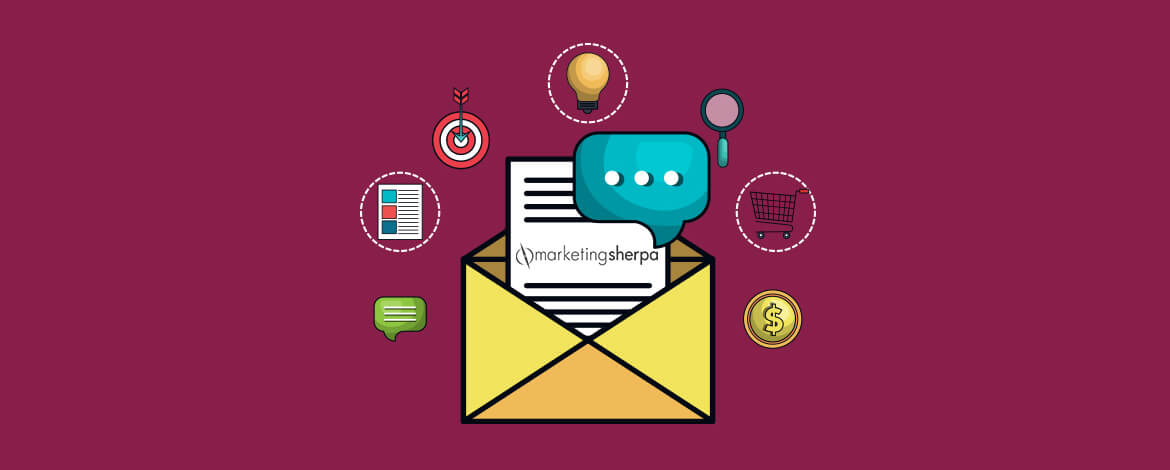In an insightful discussion with Daniel Burstein, Senior Director (Content & Marketing) at MarketingSherpa and MECLABS Institute, he tells us how MarketingSherpa has been using innovative strategies to keep their subscribers engaged.
What are the strategies implemented by MarketingSherpa to increase email engagement?
Daniel Burstein: Simply put, we always try to give more than we get. To that end, the vast majority of our sends are helpful content. Here’s an example of a blog post we would send (with a topic that also happens to be relevant to this discussion) – Email Marketing: 6 steps to re-engaging subscribers and cleaning your list database.
Provide more value to your email subscribers
than you ask for in return.
When we send out that helpful content, we do it in two ways. Like many other emailers sending content, we have traditional newsletters that include our best content of the week or month.
Here’s an example ->

However, when individual pieces of content are published, we also send it in a letter-style format to the most relevant sub-list and we make clear that they can email us back. In this way, the best call-to-action in an email can simply be a reply.
One way we do this is with a simple P.S. that says “Our job is to help you do your job better. Reply to this email to let us know how we can help.”
Here’s an example, it was the email you replied to Sam, asking me to contribute to this article.

And I think this is key to keeping subscribers engaged with email marketing. Email isn’t like other one-way marketing mediums like digital display ads, TV commercials, or print advertising. Think how real people use email. They communicate with each other. It’s an inherently two-way medium.
Add the Human Touch, Add Life to Your Emails
I will never understand brands that use no reply emails. You should look at all your marketing and ask – how can I bring humanity back to these interactions? Even, it should be noted, when you are using technology. You can execute the technology in a way that brings humanity to the communication. After all, in the examples provided here, we are using a marketing automation software.
“Why on Earth would you put on your email – Note: This email was automatically generated from a mailbox that is not monitored. That de-humanizes the conversation” – @DanielBurstein (Tweet This)
Perhaps you might think it’s too expensive to monitor mailboxes for response. If that is the case, I would respectfully ask you to take a closer look at your marketing budget.
Listen to Your Customer to Improve Engagement (err… Experience)
A customer response is a thing of value. Even if it’s a complaint! After all, the complaint gives you the opportunity to:
- Save a customer, which depending on the lifetime value of your customers and new customer acquisition costs can be valuable in its own right.
- Avoid negative word-of-mouth – in person, on social media, through review sites like Yelp, on industry forums, etc.
- Gain valuable business intelligence about your product. If people keep emailing you and telling you that the sprocket is breaking on your product, use a higher-quality sprocket!
Pleasantly and helpfully responding to customers who reply to your emails can be a disruptively positive experience. For example, here’s one piece of feedback we got after a customer service email interaction that started with a response to one of our email sends.
“Thank you for your expertise on the matter. The articles really helped me in more ways than one. Your feedback is quite fast, and I must say that I’m super impressed with your quality of communication! Hats off to you guys for being bomb af! I really will recommend this to all I know!”
Now, I’ve mostly focused on our content sends up to this point. And as I said, our main focus is to give more than we get through email to our subscribers. However, there are times when we have to ask them to take a certain conversion action as well, of course.
Very rarely, we’ll do an email send to our entire list of active email subscribers or a large segment of them.
What techniques do you primarily use to enhance email engagement and maintain an active subscriber list?
Daniel Burstein: At MarketingSherpa, we more frequently use one of the four techniques below for our marketing.
- An ask in our newsletter, which also includes helpful content.

- Send valuable content through email that gets people on the website, and then make an ask on the website.

- Send a one-to-few email to be able to humanize the email and make it highly relevant to a small group. For example, the below email went to 77 subscribers. Again, we’re trying to truly humanize and personalize communication. We’re using technology to do it. Our marketing automation platform helps us identify these microsegments using behavioral and demographic data, and then as you can see in the email below, we’re using personalization fields in the email.
Even in this case, the goal of the email is to serve the customer, and the call-to-action only comes in the P.S.

- True one-to-one emails. Obviously, this would be time intensive to send to everyone on our list. So, we build a dynamic list with our marketing automation platform using certain actions and other criteria to determine who we should email one-to-one. Even with the best automated criteria, it also takes a human being eyeballing that dynamic list as well. Here’s an example email.Subject: Need any help?
 What skillful email strategies does MarketingSherpa use to re-engage in-active subscribers?Daniel Burstein: MarketingSherpa sends a re-engagement email to a subscriber after 6 months of inactivity (Activity is measured as a click in an email). Here is a copy for that email…
What skillful email strategies does MarketingSherpa use to re-engage in-active subscribers?Daniel Burstein: MarketingSherpa sends a re-engagement email to a subscriber after 6 months of inactivity (Activity is measured as a click in an email). Here is a copy for that email…
In case any subscribers are inactive for a year, they are added to a suppression list and then MarketingSherpa and MarketingExperiments (its sister publication) stop sending them their regular emails. Thereafter, a two-step drip to re-activate them is sent. 1st Drip Email

And for the second email in the drip (for those who haven’t clicked on the above), we resend the above email but include this note with it.
2nd Drip Email

If they do click on the email (after either the first or second send), those subscribers are considered to be re-activated, we start emailing them again, and send them the below note on top of the original email.
 I’d also like to share that he would like to do more to re-engage subscribers, but like any organization there are endless demands for budget and time. He also adds that frankly speaking this is a lower priority than some other activities for marketers. But perhaps some of these thoughts might give your audience ideas of their ow.
I’d also like to share that he would like to do more to re-engage subscribers, but like any organization there are endless demands for budget and time. He also adds that frankly speaking this is a lower priority than some other activities for marketers. But perhaps some of these thoughts might give your audience ideas of their ow.
Signing off: Change the Game with 2 Cents from Daniel Burstein
– Subscriber inactivity may be due to increasingly aggressive clutter, spam, priority inbox, etc. automated sorting folders used by Gmail, Yahoo!, Outlook and other email readers.
Pro-tip: Engaging with a deliverability consultant to improve our inbox placement could be helpful.
– Inactivity may be due to how often marketers/subscribers change jobs. Average CMO tenure is now 42 months, according to Spencer Stuart.
Pro-tip: Uploading lists of inactive email recipients to Twitter and Facebook and then re-marketing to them to get them back on our list could be helpful. Also, working with a B2B data service platform can help you track people as they change jobs.
So, just like you send occasional one-to-one emails to people who are especially important to you based on certain factors, you can manually track some people who have changed jobs and reach out via LinkedIn occasionally. However, that kind of activity would be impractical to do manually for a mammoth list size.



Kevin George
Latest posts by Kevin George (see all)
24 Experts Speak: How to Improve Engagement with Your Email Subscribers and Re-Engage Inactives
20 Pro Email Design Tips for Every Email Designer to Follow